Welcome to PALFORZIA®
PALFORZIA is the first and only FDA-approved non-injectable treatment for children ages 1 through 17 years with peanut allergy.1,2
It is an oral peanut allergen powder treatment that allows for monitored exposure to consistent and precise amounts of peanut protein every day, gradually increasing your child’s tolerability to peanuts.1
The patient images are AI generated and are not real patients treated with PALFORZIA.
Individual results will vary with each patient.

PALFORZIA can help reduce the severity of allergic reactions, including anaphylaxis, that may occur with
accidental exposure to peanut.1
This precise dosing is intended to help your child’s body gradually increase tolerability to peanut in a controlled way.1,4


Helping reduce the severity of allergic reactions, including anaphylaxis,
that may occur with accidental exposure to peanut.1
The first dosing day appointment happens at the doctor’s clinic or hospital.
Starts one to four days after dose initiation.
Combines in-clinic dose
increases with at-home dosing.
60 minute appointments,
about every 2 weeks.
Maintenance, the final step, involves taking a 300 mg sachet once per day at home.
Dosing is gradually increased throughout the day starting at:
After each dose is given, your child will wait 20–30 minutes to make sure doses can continue. However, after the final dose for their appropriate age, your child’s allergy specialist will observe your child for 60 minutes.
Should a reaction occur, your child’s allergy specialist will treat it accordingly, which may include discontinuing PALFORZIA.
Dosing is gradually increased including clinic or hospital and at-home treatment:
The Maintenance step requires ongoing dosing to help your child sustain reduced sensitivity to peanut allergens.
Remember, PALFORZIA is not a cure for peanut allergy, so it is important for your child to continue avoiding peanuts and always carrying epinephrine. Your doctor will determine the frequency of follow-up visits and your child’s individual treatment plan while in the Maintenance phase.
*PALFORZIA clinical studies were for a duration of 6 months of Maintenance treatment.
Every first dose of a new dosing level will always take place at the doctor’s office.
Your child’s doctor may adapt the treatment process to your child’s unique needs at their discretion.
It is important to speak with your child’s doctor if you have any questions and to follow their instructions for your child’s
individual treatment.
To take PALFORZIA, the powder should be mixed into your child’s favorite snack.
Just make sure the food is semi-solid and either refrigerated or at room temperature, like yogurt, applesauce, or pudding. Prepare just enough food that your child will eat it all in one go.1


Models for illustrative purposes only.

Evidence for PALFORZIA
You’ll see the key endpoints for the PALFORZIA studies below. Endpoints are the specific results researchers
measure in a study to understand how well a treatment works.
The primary endpoint is the main question the study is trying to answer. Secondary endpoints are additional
important results that help researchers better understand the treatment’s effects.
Exploratory endpoints are early ideas or extra questions researchers are curious about, but they are not the primary
focus of the study.
Models for illustrative purposes only.
Toddler study (1–3 years)
Pediatric study (4–17 years)
Safety information
Primary endpoint
More than7 in 10
(75.3%) increased tolerability to
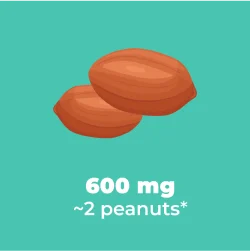
vs. around 1 in 20 (6.3%) receiving placebo (non-active treatment)
Secondary endpoint
Around 8 in 10 (79.6%) increased tolerability to
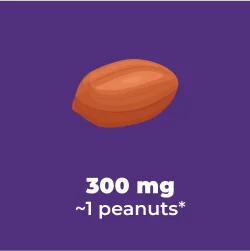
vs. around 1 in 5 (22.9%) receiving placebo (non-active treatment)
Secondary endpoint
Around 7 in 10 (68.4%) increased tolerability to
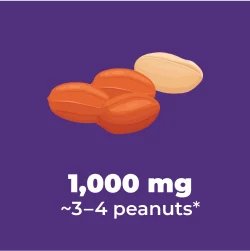
vs. around 1 in 25 (4.2%) receiving placebo (non-active treatment)
Exploratory endpoint
Around 6 in 10 (61.2%) increased tolerability to
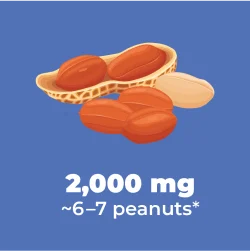
vs. around 1 in 50 (2.1%) receiving placebo (non-active treatment)
Staying on a 300 mg dose of PALFORZIA may help your child gradually become less sensitive and increase the threshold of peanut protein that the body can be exposed to over time, reducing the risk of severe reactions following accidental exposure.6
*One peanut is equivalent to 300 mg.7
Peanuts shown are for illustrative purposes only.
Peanut-specific Immunoglobulin (peanut sIgE) are the antibodies that the body produces against the allergens in peanuts, which cause your child’s body to have an allergic reaction.5,9 Peanut sIgE testing is one of the tests used by allergy specialists to determine how sensitive to peanut a patient may be.10
The graphs below show the peanut allergen sensitivity levels for both PALFORZIA-treated and placebo-treated participants in the POSEIDON clinical trial (ages 1 to <3 years) as measured by their starting and ending peanut sIgE levels.†
Key takeaways:
Toddlers who took the placebo showed that their peanut-specific IgE levels continued to increase without treatment.6
Toddlers who took PALFORZIA showed no increase in peanut-specific IgE levels.6
A rise in peanut-specific IgE was not seen among the PALFORZIA-treated toddlers vs those toddlers who received the placebo (non-active treatment) in which their peanut sensitivity (peanut sIgE levels) continued to rise.
†The data shown is an exploratory analysis of the 1 year POSEIDON clinical trial. PALFORZIA has not been studied in toddlers (1–3 years) beyond 1 year and is indicated for the mitigation of allergic reactions, including anaphylaxis that may occur with accidental exposure to peanut. The long-term variation of peanut-specific IgE levels in toddler patients has not been studied with PALFORZIA.
PALFORZIA was shown to reduce the severity of allergic reactions in children and teens.
Primary endpoint
Around 7 in 10 (67.2%) increased tolerability to
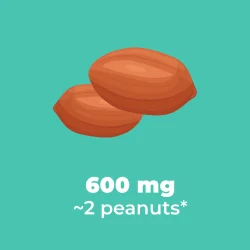
vs. around 1 in 25 (4.0%) receiving placebo (non-active treatment)
Secondary endpoint
Around 8 in 10 (76.6%) increased tolerability to
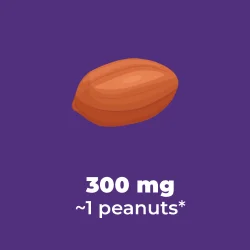
vs. around 1 in 12 (8.1%) receiving placebo (non-active treatment)
Secondary endpoint
Around 5 in 10 (50.3%) increased tolerability to
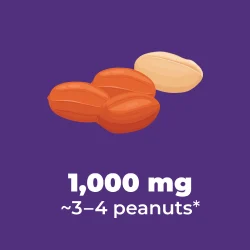
vs. around 1 in 50 (2.4%) receiving placebo (non-active treatment)
The results from the PALISADE trial showed the effectiveness of PALFORZIA treatment. The primary and secondary endpoints of the trial was to see how many participants could manage 600 mg, 300 mg, and 1,000 mg of peanut with no more than mild allergic symptoms.
*One peanut is equivalent to 300 mg.7
Peanuts shown are for illustrative purposes only.
In an open-label follow-on to the PALISADE trial, the majority of participants (n=358) completed the initial study and continued onto the follow-on study. Of the total number of participants receiving PALFORZIA treatment for up to 2 years, about 100 patients had previously received placebo (non-active treatment) and 256 continued to receive PALFORZIA through the follow-on study.11
Participants who received a daily 300 mg dose of PALFORZIA at 2 years demonstrated:11
taking PALFORZIA increased tolerability to
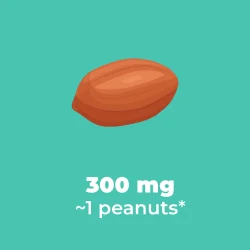
taking PALFORZIA increased tolerability to
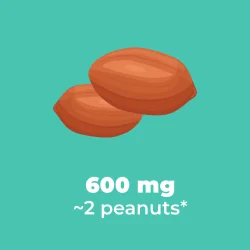
taking PALFORZIA increased tolerability to
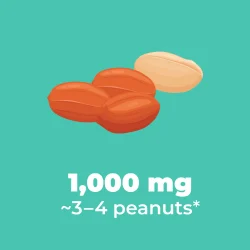
taking PALFORZIA increased tolerability to
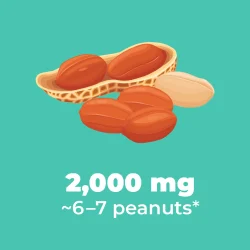
These results from the trial shown above were the percentage of patients managing peanut protein with no more than mild allergic symptoms during a food-challenge.
*One peanut is equivalent to 300 mg.7
Peanuts shown are for illustrative purposes only.

See below for more information. These are not all the possible side effects of PALFORZIA. It is important to talk to your child’s doctor if you have any questions about PALFORZIA treatment.
(ages 1–3 years)
(ages 4–17 years)
Contact your child’s doctor if any of these allergic reactions occur. If your child has a severe allergic reaction during PALFORZIA treatment, they should stop taking PALFORZIA, administer epinephrine, as prescribed by your child’s doctor, immediately and get emergency medical help.
Stop taking PALFORZIA and get emergency medical treatment right away if you have any of the following symptoms after taking PALFORZIA: Trouble breathing or wheezing, chest tightness or discomfort, throat tightness, trouble swallowing or speaking, swelling of your face, lips, eyes, or tongue, dizziness or fainting, severe stomach cramps or pain, vomiting, or diarrhea, hives (itchy, raised bumps on the skin), or severe flushing of the skin.12
Additional symptoms in young children may include inconsolable crying, excessive sleepiness, and drawing the legs up to the stomach.12
Uncontrolled asthma
Ever had eosinophilic esophagitis (EoE) or other eosinophilic
gastrointestinal disease
PALFORZIA does NOT treat allergic reactions and should not be given during an allergic reaction.
PALFORZIA is only intended to treat children with a diagnosed peanut allergy; it is not effective against other food allergies.
It is important to maintain a peanut-free diet while on PALFORZIA and carry epinephrine.
PALFORZIA is a prescription medication only available through a doctor.
Find information about starting treatment, including how to get your child’s prescription.
The patient images are AI generated and are not real patients treated with PALFORZIA.
Individual results will vary with each patient.


References:
PALFORZIA can cause severe allergic reactions called anaphylaxis that may be life-threatening and can occur at any time during PALFORZIA therapy.
PALFORZIA is a treatment for people who are allergic to peanuts. PALFORZIA can help reduce the severity of allergic reactions, including anaphylaxis, that may occur with accidental exposure to peanut. PALFORZIA may be started in patients aged 1 through 17 years old. If you turn 18 years of age while on PALFORZIA treatment you should continue taking PALFORZIA unless otherwise instructed by your doctor. PALFORZIA does NOT treat allergic reactions and should not be given during an allergic reaction, including anaphylaxis. You must maintain a strict peanut-free diet while taking PALFORZIA.
Stop taking PALFORZIA and get emergency medical treatment right away if you have any of the following symptoms after taking PALFORZIA:
Because of the risk of severe allergic reactions, PALFORZIA is only available through a restricted program called the PALFORZIA Risk Evaluation and Mitigation Strategy (REMS) Program. PALFORZIA is a prescription only medication. Talk to your healthcare provider for more information about the PALFORZIA REMS program and how to enroll.
You should NOT take PALFORZIA if you have uncontrolled asthma, or if you ever had eosinophilic esophagitis (EoE) or other eosinophilic gastrointestinal disease.
Tell your doctor if you are not feeling well prior to starting treatment with PALFORZIA. Your doctor may decide to delay treatment until you are feeling better. Also tell your doctor about any medical conditions you have and if you are taking or have recently taken any other medicines, including medicines obtained without a prescription and herbal supplements.
Your doctor may decide that PALFORZIA is not the best treatment if:
What are the possible side effects of PALFORZIA?
The most commonly reported side effects of PALFORZIA in ages 1 through 3 years were: cough, sneezing, runny nose, nasal congestion, throat irritation, wheezing, stomach pain, vomiting, diarrhea, itchy mouth, pain in the throat, hives, rash, itchy skin, and/or inflammation of the skin around the mouth.
The most commonly reported side effects of PALFORZIA in ages 4 through 17 years were: stomach pain, vomiting, feeling sick, itching or burning in the mouth, throat irritation, cough, runny nose, sneezing, throat tightness, wheezing, shortness of breath, itchy skin, hives, and/or itchy ears.
PALFORZIA can cause severe allergic reactions called anaphylaxis that may be life-threatening.
PALFORZIA can cause stomach or gut symptoms including inflammation of the esophagus (called eosinophilic esophagitis). Symptoms of eosinophilic esophagitis can include:
For additional information on PALFORZIA and/or the possible side effects, talk with your doctor or pharmacist.
Please see full Prescribing Information, including Boxed WARNING and Medication Guide.
You are encouraged to report negative side effects of prescription drugs to the FDA. Visit www.fda.gov/medwatch or call 1-800-FDA-1088.